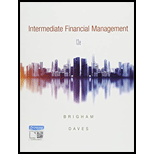
Concept explainers
a)
To determine: Cash flows at year 0.
a)
Explanation of Solution
Calculation of cash flows at year 0:
Therefore, the year 0 cash flow is -$89,000
b)
To determine: Net operating cash flows for 3 years.
b)
Explanation of Solution
Calculation of
Cost of the machine is $85,000 ($70,000+$15,000)
Calculation of operating cash flows:
Therefore, the net operating cash flow at year 1 is $26,332.4
Therefore, the net operating cash flow at year 2 is $30,113.2
Therefore, the net operating cash flow at year 2 is $20,035.6
c)
To determine: Additional year-3 cash flow required.
c)
Explanation of Solution
Book value is $6,298.50
Calculation of profit on sale:
Therefore, profit on sale is $23,701.50
Calculation of taxes on salvage value:
Therefore, taxes on salvage value is $20,519.40
Calculation of additional cash flow at year 3:
Therefore, additional cash flow required is $24,519.40
d)
To determine: Whether the firm should accept the project or not.
d)
Explanation of Solution
Calculation of NPV:
Excel workings:

Excel spread sheet:

Therefore, the
Want to see more full solutions like this?
Chapter 13 Solutions
Bundle: Intermediate Financial Management, 13th + MindTap Finance, 1 term (6 months) Printed Access Card
- critically discuss the hockey stick model of a start-up financing. In your response, explain the model and discibe its three main stages, highlighting the key characteristics of each stage in terms of growth, risk, and funding expectations.arrow_forwardSolve this problem please .arrow_forwardSolve this finance question.arrow_forward
- solve this question.Pat and Chris have identical interest-bearing bank accounts that pay them $15 interest per year. Pat leaves the $15 in the account each year, while Chris takes the $15 home to a jar and never spends any of it. After five years, who has more money?arrow_forwardWhat is corporate finance? explain all thingsarrow_forwardSolve this finance problem.arrow_forward
 Intermediate Financial Management (MindTap Course...FinanceISBN:9781337395083Author:Eugene F. Brigham, Phillip R. DavesPublisher:Cengage LearningPrinciples of Accounting Volume 2AccountingISBN:9781947172609Author:OpenStaxPublisher:OpenStax College
Intermediate Financial Management (MindTap Course...FinanceISBN:9781337395083Author:Eugene F. Brigham, Phillip R. DavesPublisher:Cengage LearningPrinciples of Accounting Volume 2AccountingISBN:9781947172609Author:OpenStaxPublisher:OpenStax College EBK CONTEMPORARY FINANCIAL MANAGEMENTFinanceISBN:9781337514835Author:MOYERPublisher:CENGAGE LEARNING - CONSIGNMENT
EBK CONTEMPORARY FINANCIAL MANAGEMENTFinanceISBN:9781337514835Author:MOYERPublisher:CENGAGE LEARNING - CONSIGNMENT


